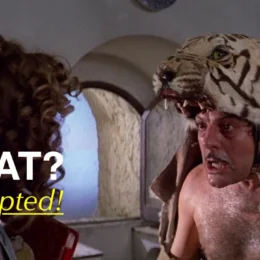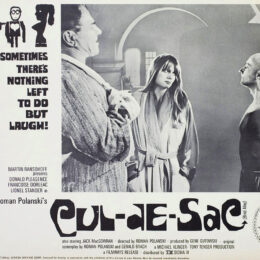THE TENANT. Voyeurism, Claustrophobia, and Self-Referentiality in Roman Polanski’s Work

In Roman Polanski’s cinema, the truth is often a fabrication, and the chosen genre serves to outsmart the audience and prove that within seriousness lies a grain of absurdity.
Related:
One of my favorite techniques consistently used by Polanski is prolonging the action in such a way that the viewer cannot discern what they are precisely dealing with. In Frantic, the opening sequence hints at a marital melodrama, and for several minutes, literally nothing happens until suddenly the film transforms into a pure, almost Hitchcockian thriller, ending with a delightful genre twist, even though, in reality, it’s the odyssey of a lost man on the streets of Paris. In Tess, a historical romance is parodied to mock the sentimental convention that narrates the sexist past.
Similarly, in the case of The Tenant from 1976, Polanski doubly achieves the intended effect: not only does he play with the idea behind the framework of a suspense film, but he also teases the memories of the audience by remixing his earlier works, Repulsion and Rosemary’s Baby. The discussed The Tenant as the third part of the so-called ‘apartment trilogy,’ is strongly rooted in the previous two titles and serves as a summary of Polanski’s earlier years of work.

It all starts with a camera moving through the windows of an apartment building, reminiscent of Hitchcock’s Rear Window. Sinister foreshadowing turns into tragicomic escapades of Trelkovsky (played by the director himself), in which elements of horror, thriller, comedy, and romance converge. For many minutes, it’s unclear which direction the plot is heading. At times, Polanski is playful, especially when portraying himself as a shy and timid immigrant seeking a peaceful and prosperous life in Paris. Other times, he creates a paranoid atmosphere akin to Franz Kafka’s works. Every few minutes, the narrative veers in a different direction, preventing the viewer from getting accustomed to the presented mood in any way.
Of course, the prevailing feeling is one of persecution, always haunting Trelkovsky as if he were under constant observation by society, especially by the neighbors in the apartment building he moved into. He doesn’t want to disturb anyone, and like a chameleon, he tries to blend into his surroundings, but the harder he tries, the worse it gets. The tragic avalanche begins with a party he hosts for noisy acquaintances. From that moment, he begins to perceive aggression directed at him from all sides. Each neighbor starts complaining about the sounds emanating from his apartment, and he becomes increasingly unwelcome in the building.
The Kafkan atmosphere of isolation and the struggle with the inexplicable mechanisms of the absurd world mixes with immigrant melancholy reminiscent of Nabokov’s “Maschenka.” Trelkovsky has French citizenship, but his last name gives him away. He is not “one of us,” yet he is not Polish either. His identity crisis, compounded by the vile treatment he receives from others, only strengthens the tendency that disconnects the protagonist’s consciousness from reality. The longer he stays at home, away from the world, the more he becomes entangled in his own phobias and compulsions.

This might be an overly far-reaching interpretation, but at times, The Tenant seems like a depiction of a survivor’s struggles to return to normalcy after the Second World War’s chaos. This is indicated, among other things, by a scene in which Trelkovsky, dressed as a woman, watches from his window as a woman in the courtyard is captured by an angry mob. Later, the protagonist hides behind a cupboard to avoid being caught himself. Trauma from the Holocaust does not necessarily manifest in a literal way; mere compulsion to remain quiet and an insistent need to avoid attention can be enough, especially considering Polanski’s own experiences, which may reflect a need to tell how to cope when war memories continue to consume one’s mind. After all, as the protagonist mentions at one point, in today’s times, having contact with neighbors can be somewhat troublesome.
Alongside the seriousness in dealing with the emotional alienation felt by the protagonist, humor emerges. Trelkovsky attempts to get closer to Stella (Isabelle Adjani), but he’s far from being a Don Juan. His friends also make fun of him, constantly teasing and mocking his aloofness.
However, it seems that, as has often been the case before and after, Polanski’s main interest in The Tenant was self-referential, i.e., the impact of film on the viewer. After all, the central theme of the film is voyeurism of various kinds – Trelkovsky spies on people in the bathroom across his window, he himself feels observed, often characters peek through the peephole in his door, and there’s a scene in which Simone Choule, the woman who previously lived in his apartment, watches him during a hospital visit. Simone had attempted suicide and died a few days later, and in the meantime, she would occasionally glance at Trelkovsky, who had come to the hospital to check on her. Furthermore, the protagonist, along with Stella, goes to the movies to see a Bruce Lee film, and at one point, Polanski’s character starts to resemble the previous tenant of the apartment.

“When you look at the film, it looks at you,” one could paraphrase Nietzsche’s words in the context of The Tenant. The longer Trelkovsky observes the residents of the building, the more he feels watched himself. The more he gets drawn into paranoid suspicions, the more his fate becomes parallel to Simone’s. The man, from the viewer’s perspective – an outsider to the world of the narrative – becomes an actor, as exemplified by the penultimate scene when everyone in the building gathers in the courtyard and on the balconies, like an audience, waiting for the new tenant to finally jump from the window. Then, at the end, when a male scream comes from a bandaged individual, we receive the ultimate confirmation – Trelkovsky followed in Simone’s footsteps. He was so preoccupied with her and empathetic to her situation that he followed the path she had paved. Does this mean that Polanski in The Tenant warns against excessive belief in the truth of art, which is, in reality, just a costume and a masquerade?
It’s difficult to provide a definitive answer to this question because Polanski operates on two levels simultaneously. He works seriously, creating a poignant portrayal of a persecuted individual while at the same time invalidating these events by playing with an even greater sense of fiction, artificiality, and conventionality of the presented events. Although not equal to his earlier Repulsion, it should still be regarded as an important step in Polanski’s career. At that time, a new stage in the director’s work began, where he began to summarize and reinterpret his earlier achievements. The Tenant was merely a prelude to more important productions from this ‘stream’ – Tess, Bitter Moon, and, above all, Frantic.





